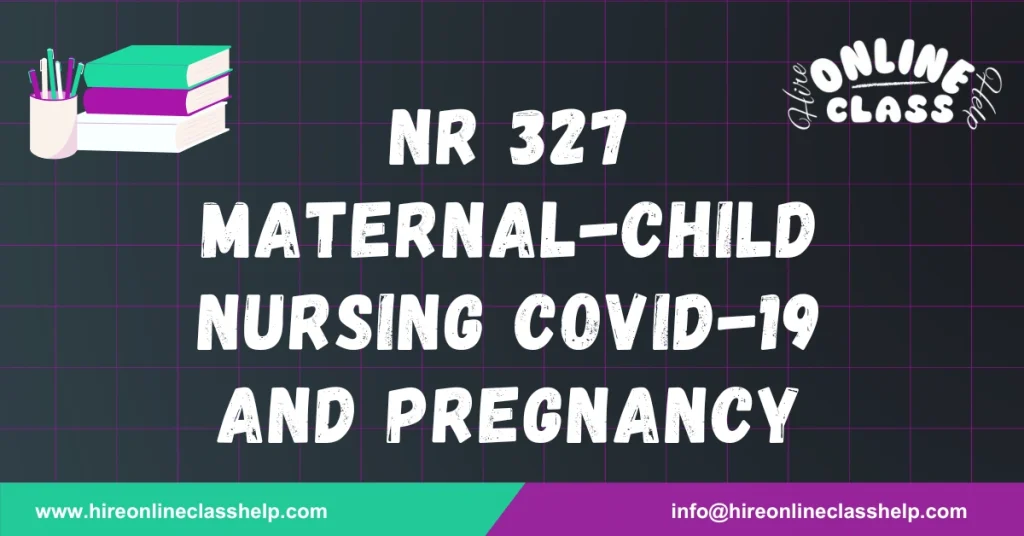






Name
Chamberlain University
NR-327: Maternal-Child Nursing
Prof. Name
Date
The year 2020 will be etched in history as a time when humanity confronted an unparalleled challenge—the worldwide outbreak of a novel coronavirus known as COVID-19. This pandemic has drastically impacted millions globally, reshaping our daily lives. Social gatherings have been restricted, mask-wearing in public has become standard practice, and even a simple cough can elicit concern. However, the ramifications of COVID-19 extend well beyond everyday life, significantly affecting the healthcare sector. Hospitals and healthcare providers are grappling with substantial obstacles, including a surge in patients infected with the virus, shortages of personal protective equipment (PPE), and widespread burnout among healthcare workers.
Within the healthcare context, it is imperative to explore the intersection of COVID-19 and pregnancy. This article seeks to examine how the virus impacts expectant mothers, the developing fetus, and newborns during both the antepartum and intrapartum stages. Additionally, it will discuss preventative measures that pregnant women can adopt to mitigate their risk of contracting the virus.
COVID-19, as a newly identified virus, remains a topic of ongoing research and investigation as new information becomes available. The global emphasis is on developing an effective vaccine, given the rising number of infections and fatalities. While our understanding of the virus is continually evolving, certain aspects have been firmly established, including its symptoms, complications, modes of transmission, and the populations most at risk.
The incubation period for COVID-19 generally varies from two to fourteen days, with an average duration of about five days. However, this period can differ based on age and preexisting health conditions. The most frequently reported symptoms of COVID-19 include cough, fever, fatigue, sputum production, sneezing, headache, hemoptysis, shortness of breath, sore throat, and lymphopenia. Complications associated with the virus can range from acute respiratory distress syndrome and pneumonia to acute cardiac injury, hypoxemia, and, in severe cases, death. COVID-19 primarily spreads through respiratory droplets emitted during coughing, sneezing, and speaking. Recent research has also indicated a link between COVID-19 and preeclampsia, a condition characterized by elevated blood pressure during pregnancy.
Several risk factors have been identified that contribute to the severity of COVID-19. These include age, as older individuals are more susceptible, and preexisting health conditions such as respiratory and cardiovascular diseases, impaired renal function, and elevated D-Dimer and troponin levels. Furthermore, males over 50 years of age are at a higher risk of mortality due to COVID-19. As research continues, it is crucial to stay informed about the evolving understanding of COVID-19, its effects, and the necessary measures to lessen its impact.
The antepartum period refers to the duration preceding labor and delivery, involving the physiological changes experienced by the mother and the development of the fetus. However, during the COVID-19 pandemic, pregnant women are confronted with an increased risk of adverse outcomes, complications, extended hospital stays, intensive care unit (ICU) admissions, and even mortality. Pneumonia, a frequent complication of COVID-19, can progress to severe acute respiratory syndrome (SARS). Pregnant women with pneumonia related to COVID-19 are also at risk for sepsis, disseminated intravascular coagulopathy (DIC), secondary bacterial infections, and renal failure. The timing of COVID-19 infection during pregnancy can also significantly influence these outcomes.
Advice for the public on COVID-19. (2020). Retrieved November 28, 2020, from https://www.who.int/emergencies/diseases/novel-coronavirus-2019/advice-for-public
Dashraath, P., Wong, J. L., Lim, M. X., Lim, L. M., Li, S., Biswas, A., & Su, L. L. (2020). Coronavirus disease 2019 (COVID-19) pandemic and pregnancy. American Journal of Obstetrics and Gynecology, 222(6), 521-531. doi:10.1016/j.ajog.2020.03.021
Daribi, K., Awulachew, E., & Get, E. (2020). The effect of coronavirus infection (SARS-CoV-2, MERS-CoV, and SARS-CoV) during pregnancy and the possibility of vertical maternal–fetal transmission: A systematic review and meta-analysis. European Journal of Medical Research, 25(1). doi:10.1186/s40001-020-00439-w
How to protect yourself & others. (2020). Retrieved November 28, 2020, from https://www.cdc.gov/coronavirus/2019-ncov/prevent-getting-sick/prevention.html
Long-term effects of COVID-19. (2020). Retrieved November 28, 2020, from https://www.cdc.gov/coronavirus/2019-ncov/long-term-effects.html
Mascio, D. D., Khalil, A., Saccone, G., Rizzo, G., Boca, D., Liberati, M., & Antonio, F. (2020). The outcome of coronavirus spectrum infections (SIRS, MERS, COVID-19) during pregnancy: A systematic review and meta-analysis. American Journal of Obstetrics & Gynecology MFM, 2(2), 100107. doi:10.1016/j.ajogmf.2020.100107
McIntosh, K. (2020, November 22). Coronavirus disease 2019 (COVID-19): Epidemiology, virology, and prevention (M. S. Hirsch & A. Bloom, Eds.). Retrieved November 28, 2020, from https://www.uptodate.com/contents/coronavirus-disease-2019-covid-19-epidemiology-virology-and-prevention
Mikami, T., Miyashita, H., Yamada, T., Harrington, M., Steinberg, D., Dunn, A., & Siu, E. (2020). Risk factors for mortality in patients with COVID-19 in New York City. SSRN Electronic Journal. doi:10.2139/ssrn.3588532
Mullins, E., Evans, D., Viner, R. M., O’Brien, P., & Morris, E. (2020). Coronavirus in pregnancy and delivery: Rapid review. Ultrasound in Obstetrics & Gynecology, 55(5), 586-592. doi:10.1002/log.22014
Rasmussen, S. A., Malian, J. C., Lednicky, J. A., Wen, T. S., & Jamieson, D. J. (2020). Coronavirus disease 2019 (COVID-19) and pregnancy: What obstetricians need to know. American Journal of Obstetrics and Gynecology, 222(5), 415-426. doi:10.1016/j.ajog.2020.02.017
Ruthann, H. A., & Byrareddy, S. N. (2020). The epidemiology and pathogenesis of coronavirus disease (COVID-19) outbreak. Journal of Autoimmunity, 109, 102433. doi:10.1016/j.jaut.2020.102433
Schwartz, D. A. (2020). The effects of pregnancy on women with COVID-19: Maternal and infant outcomes. Clinical Infectious Diseases, 71(16), 2042-2044. doi:10.1093/cid/ciaa559
Signaled, S. S., & Kalan, M. E. (2020). Care of newborns born to mothers with COVID-19 infection: A review of existing evidence. The Journal of Maternal-Fetal & Neonatal Medicine, 1-13. doi:10.1080/14767058.2020.1777969
Yang, H., Wang, C., & Poon, L. C. (2020). Novel coronavirus infection and pregnancy. Ultrasound in Obstetrics & Gynecology, 55(4), 435-437. doi:10.1002/uog.22006